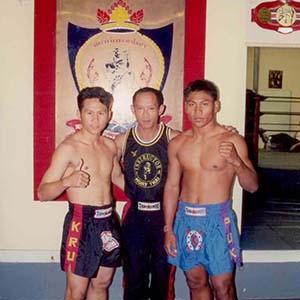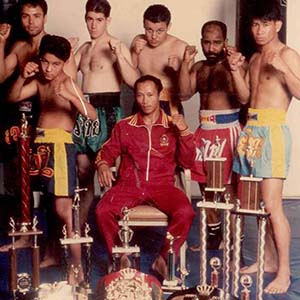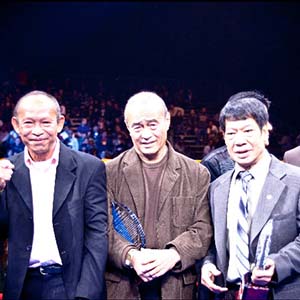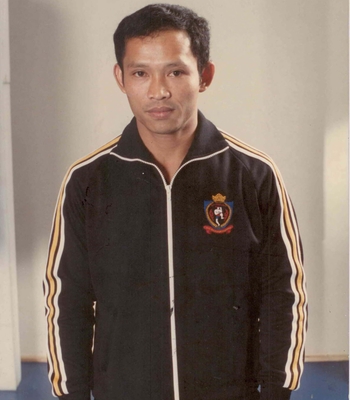- Legend of Amarican Muay thai -
Surapuk Jamjuntr (kru Puk)
Following His Dream
Surapuk Jamjuntr wanted to fight so bad he could taste it. The ten-years-old saw his friends take off for muay thai class everyday.He delighted in their stories of the arduous training,the long hours in the gym,the trill of hitting without getting hit. And for a while, living vicariously through his friends and schoolmates was as close as he got to legitimate muay thai training. You see, Surapuk (nicknamed “Puk”) came from a rather upscale family in Si Sa Ket, a small province in Thailand’s eastern region. Puk’s father, president of the local school district.wanted his son to follow a more “respectable” path in life. “My father and m–other wanted me to study to be a lawyer,” puk recalled, “They only wanted me to study. They figured if l fought I would damage my brain. They didn’t want me to get hurt.”
Fight for Life
For many youth in Puk‘s town, fighting was not only a way of life, but also a way to support your Family. “In Thailand, they fight for their lives,” notes Puk. “Some- times the families are poor and they don’t have any money. The only way they can make money, the only way they can support themselves is through fighting. “In our town, fighters had everything.” he adds. “In our home- town, for every ten houses there might have been one black and white television. No radio, no toilets, streets made of rock.” Puk, however, had it comparatively easy. Still, he could only see the present. Muay Thai was in full frame. There was some- thing about the sport of Thai kickboxing which drew him like a moth to a street lamp. The more he saw it, the more he had to be part of it. Nothing could keep him away not his parents, not their words of caution, not even their threats. And so Puk did what every young kid does in a similar situation. He disobeyed his parents and headed for the gym. “Every-time I fought, every-time I trained I had to hide it from my parents,” recalls Puk. “I knew they’d get mad, I knew they’d try to stop me if they Found out. But I couldn’t stop. I really Felt like this was the sport for me. I couldn’t get enough of it.”
Hide No More
At first Puk just trained after school. As he become better and more skilled, his workouts increased to 90 minutes in the morning before classes and two and a half hours in the evening. His initial workouts included jogging, shadowboxing, heavy bag training, and sparring with pads. Puk hid it as long as he could, but fame especially the kind muay Thai brings in the sport’s birthplace soon caught up with him. By the time his parents discovered his secret passion, however, Puk was a household name everywhere but the Jamjuntr household. The die had been cast. “There was really nothing they could do about it,” he explains. “And by the time they found out I was bigger and winning so they said it was okay.” In fact, Puk made a habit of winning, which to his parents translated into keeping his brain waves from skipping a beat. He joined his first muay Thai camp at 11 and won his opening bout a fourth-round KO a year later. The purse? $1.50. Puk remembers his maiden ring voyage like it was yesterday. “In the beginning, I forgot every technique I had learned in the gym,” he says, laughing. “But it’s a lot like swimming. After ten fights I started to use my brain in the ring. I developed my own style and started to control the fight with defense and counter’ punching.”
A Career Blossom
It hasn’t been easy. It’s one thing to teach Thai boxing to the natives; it’s another thing entirely to teach your national sport to a culture raised on baseball America’s national sport. “At first it was hard because many Americans had never heard of muay Thai,” he relates. “It was like introducing a whole new martial art. But when they saw videos of training and fights and when they got to meet Thai champions, the interest grew right away.” Today, Puk’s job has been made infinitely easier by the popularity of professional muay Thai promotions throughout the United States. “People attend a light and they immediately get hooked,” explains Puk. “‘l’hey love the action. they love the way the fighters use their entire body in a match. They see how muay thai is perfect for both health and self-defense. “Muay Thai is the only sport that incorporates every part of the body punching, kicking, knees. elbows. locking to attack and defend with power,” he adds. “It is a complete martial art with many benefits.” Still, Puk maintains even the best martial art is of little use in the hands of poor teacher. And contrary to popular belief. great fighters don’t always make great teachers. “A teacher has to be patient,” he insists. “He has to under- stand the limitations of his students. He not only has to know the system, but he has to explain it in a way that the student will understand. Otherwise, the student will get frustrated and quit. Someone may be a great champion, but if he can’t translate what he knows to others, then his knowledge is lost.” Today, the 46-year-old Puk is one of the country’s most respected teachers. But what has made him so great is that he always has been one of the sport’s finest students. “When I was younger, I watched and listened to the way the great instructors explained the material,” he remembers. I took the best of their teaching techniques.” With 35 years of muay Thai under his belt, Puk continues to teach the art to new students, develop champion fighters and spread the positive aspects of the art throughout the world. Not actually what mom and dad had in mind, but not bad just the same. “If my Parents saw me now they’d bc happy with the way I turned out,” he says matter-of-Factly.
Uphill Climb
Puk stayed with the local camp through high school and then moved to Udon Thani to begin college, where he eventually earned a degree in physical education. While Puk was studying gymnastics, wrestling, judo, boxing, calisthenics and teaching, he also was competing in school sponsored muay Thai tourna- ments. At 21, he found a camp called Lookpalabodee and began fighting under the name Vayupak Lookpalabodee. In becoming one of the area’s most legendary fighters, Puk amassed a 60-12 mark with three draws. At the same time, Puk also dabbled in amateur boxing in college where he won a respectable 35 of his 50 fights. His 15 losses were all by decision. The most he ever made was $130. According to Puk, a good fighter not only has to have the physical skill, but he also has to be smart. Champions, he adds, possess a completed package of offensive and defensive weapons, plus the knowledge of what to use and when to use it. Puk worked in Thailand as a physical education teacher for one year before leaving his homeland for the United States in 1978. A meeting with Dr. Natachai Jiyasak, a leader in the Los Angeles Thai community, led to a job as a muay Thai instructor at a youth center. His students were Thai children ages seven-to-14. This continued until Dr. Jiyasak and his. partners opened the Muay Thai Academy of America Inc., in North Hollywood. Teaching Thai boxing to Youth is what Puk always dreamed of doing. Along With co-instructors Nanfah Siharaddacho, Detfongkong Vissanuchai, and Saekson Janjira, the school Provided American students a chance to learn authentic muay Thai history, philosophy and technique. Today, Puk still runs the academy with Kru Pongsan Ek-Yotin as his co-instructor.














